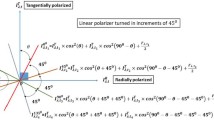Abstract
Determining the relative brightness of the solar corona is one of the most critical stages in solar eclipse studies. For this purpose, images taken with different exposures and polarization angles in white-light observations are used. The composite image of each polarization angle is produced by combining the images of different exposures. With the help of the intensity calibration function of these images, the relative intensity of the corona can be calculated. The total brightness of the solar corona is calculated using Stokes parameters obtained from intensity values of three polarization angles. In this study, two methods are presented: the first is used to obtain the intensity calibration function of the photographic material using calibration images, and the second is used to calculate the combined intensity values of images taken with different polarization angles.








Similar content being viewed by others
References
Arech, A.V., Mesadi, T., Koshel, R.J.: 2007, Field Guide to Illumination, SPIE Field Guides 11, SPIE, Bellingham.
Billings, D.E.: 1966, A Guide to the Solar Corona, Academic Press, New York.
Dürst, J.: 1982, Astron. Astrophys. 112, 241. http://adsabs.harvard.edu/full/1982A .
Fontenla, J.M., Avrett, E.H., Loeser, R.: 1993, Astrophys. J. 406, 319. DOI .
Gabriel, A.H.: 1976, Phil. Trans. Roy. Soc. London A 281, 399. DOI .
Goldstein, D.: 2003, Polarized Light, 2nd edn. Dekker, New York.
Golub, L., Pasachoff, J.M.: 2010, The Solar Corona, 2nd edn. Cambridge University Press, Cambridge.
Hurter, F., Driffield, V.C.: 1890, J. Soc. Chem. Ind., London IX, 5.
Kulijanishvili, V.I., Kapanadze, N.G.: 2005, Solar Phys. 229, 45. DOI .
McCluney, W.R.: 1994, Introduction to Radiometry and Photometry, Artech House, Norwood.
Mees, C.E.K.: 1942, The Theory of the Photographic Process, Macmillan Co., New York.
Newkirk, G., Dupree, R.G., Schmahl, E.J.: 1970, Solar Phys. 15, 15. DOI .
Owaki, N., Saito, K.: 1967, Ann. Tokyo Astron. Obs. 19, 279. ADS .
Ramberg, K.: 1951, Stockh. Obs. Ann. 16(3), 3. ADS .
Saito, K.: 1948, Ann. Tokyo Astron. Obs. 8, 63. ADS .
Saito, K.: 1956, Publ. Astron. Soc. Japan 8(3/4), 126. ADS .
Saito, K.: 1970, Ann. Tokyo Astron. Obs. 13(2), 53. ADS .
Saito, K., Hata, S.: 1964, Publ. Astron. Soc. Japan 16(3), 240. ADS .
van de Hulst, H.C.: 1950, Bull. Astron. Inst. Neth. 11, 135. ADS .
von Klüber, H.: 1958, Mon. Not. Roy. Astron. Soc. 118, 201. DOI .
Waldmeier, M.: 1964, Z. Astrophys. 60, 28. ADS .
Young, R.K.: 1911, Lick Obs. Bull. 6(205), 166. DOI .
Acknowledgements
Thanks to Başar Coşkunoğlu for his contributions for improving the language of the manuscript. Thanks especially to M. Türker Özkan and Adnan Ökten and all other staff in charge of the observations of the 1999 and 2006 solar eclipses. Thanks also to the anonymous referee for their valuable suggestions and comments that improved the manuscript. This work was supported by the Istanbul University Scientific Research Projects Commission with the project numbers 24242, UP-16/160399, and 470/27122005.
Author information
Authors and Affiliations
Corresponding author
Ethics declarations
Disclosure of Potential Conflicts of Interest
The author declares that he has no conflicts of interest.
Appendix A: Results of the Calculation for the Intensity Calibration Function Made for the Solar Eclipse on 11 August 1999
Appendix A: Results of the Calculation for the Intensity Calibration Function Made for the Solar Eclipse on 11 August 1999
The solar eclipse in 1999 was observed by the staff of the Astronomy and Space Science Department of Istanbul University at the Tokat-Turhal observation site. The telescope named T150, which and has a 150 cm focal length and 13 cm aperture size, was used for the observation. A total of 11 square diaphragms with edge lengths of 1, 1.5, 2.5, 3.5, 4.5, 5.5, 6.5, 7.5, 8.5, 9.5 and 10.5 cm were used in the intensity calibration observation. Four different exposure times of \(1/2\), \(1/4\), \(1/15\) and \(1/60\) second were selected. The measured intensities of the apparent solar disks and their backgrounds are listed in Table 4 for every exposure. The average background intensity is obtained as 1215 from the intensities of the shortest exposures. The normalized and relative intensities of the calibration images were calculated, and the results are listed in Table 5 with exposure times and diaphragm openings. In this observation, the light transmission of the solar filter and polarizer was \(f_{\text{int}}=1.6 \times10^{-5}\) and \(f_{\text{pol}}=0.3\), respectively.
A graph drawn between normalized and relative intensities is shown in Figure 9. The obtained intensity calibration function from this graph is given by
where the correlation coefficient is \(R^{\text{2}}=0.97\). The sky and instrumental contributions value is calculated as \(0.63 \times10^{-8} \bar{I}_{\odot}\) for this observation.
Rights and permissions
About this article
Cite this article
Çakmak, H. Two Practical Methods for Coronal Intensity Determination. Sol Phys 292, 186 (2017). https://doi.org/10.1007/s11207-017-1217-x
Received:
Accepted:
Published:
DOI: https://doi.org/10.1007/s11207-017-1217-x





